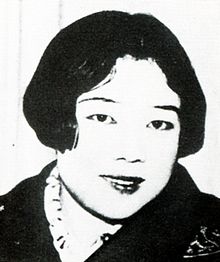Okamoto Kanoko
Okamoto Kanoko ( Japanese 岡本 か の 子 , born as Ōnuki Kano ( 大 貫 カ ノ ), born March 1, 1889 in Akasaka , Tokyo ; † February 18, 1939 ) was a Japanese writer .
Life
Okamoto belonged to the wealthy Ōnuki family, who came from landowners and merchants for generations during the Tokugawa shogunate . As a child, she was introduced to the classical Japanese arts of music, dance and literature. Influenced by her brother, the writer Ōnuki Shōsen , she attended the Atomi-Gakuen girls' school and studied at the University of Tokyo .
During this time, encouraged by Yosano Akiko , she published her first tankas in the magazine Myōjō ( 明星 ). In 1910 she married the mangaka Okamoto Ippei , the following year her son Taro was born, who became known as an avant-garde painter.
In 1912 the first of her five Tanka collections appeared under the title Karoki-netami ( か ろ き ね た み ). In order to perfect her literary training, she traveled with her family to Paris, London, Berlin and finally to the USA from 1930 to 1932. In 1936 she published the Novellette Tsuru wa Yamiki ( 鶴は病みき ) about the last days of the writer Ryūnosuke Akutagawa , where they had met the 1,923th Up until her death, the novels Boshi Jojō ( 母子 叙 情 ) and the short stories Kingyo Ryōran ( 金魚 撩乱 ) and Rōgishō ( 老 妓 抄 ) were written in quick succession . She died of a stroke in 1939 shortly before her 50th birthday.
swell
- Kamakura City, Kamakura's Literary Figures - Biography
- Sachiko Shibata Schierbeck, Marlene R. Edelstein: Japanese Women Novelists in the 20th Century: 104 Biographies, 1900-1993 . Museum Tusculanum Press, 1994, ISBN 87-7289-268-4 , p. 95–99 ( limited preview in Google Book Search).
| personal data | |
|---|---|
| SURNAME | Okamoto, Kanoko |
| ALTERNATIVE NAMES | 岡本 か の 子 (Japanese); Ōnuki Kano (real name); 大 貫 カ ノ (Japanese, real name) |
| BRIEF DESCRIPTION | Japanese writer |
| DATE OF BIRTH | March 1, 1889 |
| PLACE OF BIRTH | Akasaka , Tokyo |
| DATE OF DEATH | February 18, 1939 |
